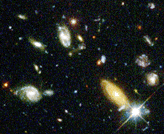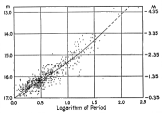A Gem of a Star
 |
| Zeta Geminorum is often called the "kneecap" of the constellation Gemini. |
Zeta Geminorum, a luminous, giant, cepheid variable star, pulsates in our galaxy at a distance of about 1100 light years from Earth. It's brilliant light is easily observable in the winter nighttime sky with the unaided eye, above and to the northeast of the constellation Orion, the hunter. As a cepheid variable star, Zeta Gem pulsates with a regular period, alternately expanding and contracting due to instabilities within the star. The ancient Arabic name for Zeta Gem is "Mekbuda," which means, "pulled-in-paw." Perhaps the ancient Arabs noticed the variability of this star and associated it with claws that can be extended or retracted.
Julius F. J. Schmidt, who later became a famous selenographer (cartographer of the moon), suspected the variability of Zeta Geminorum in 1844, when he was still a teenage amateur. Three years later, in 1847, when a student at Bonn University studying under the great variable star astronomer, F. Argelander, Schmidt confirmed the discovery of Zeta Gem. An extremely well-organized manuscript of J. F. J. Schmidt's observations from the 1840s to 1870s currently resides in the archive room at AAVSO headquarters in Massachusetts. These observations were sent to the director of the Harvard College Observatory at the time, Edward C. Pickering, by the Potsdam Observatory, where Schmidt's papers were deposited post mortem. The AAVSO, the largest variable star organization in the world with headquarters located in the Harvard College Observatory until 1954, received the observations from Pickering and now keep them stored safely in an archive room with other variable star observations. Among the observations are Schmidt's first estimates of Zeta Gem. There are several comments written in German throughout his records and in 1844 he notes (translated to English), "I first became attentive to the variability of z, in March." Then in April of the same year he writes of Zeta Gem, "...the observations before 1844, belonging to my first attempt, are very imperfect." See Figure 1 for an excerpt from Julius Schmidt's observation logbook.
The Rythym of the Cepheid Beat
Since its discovery in the 1840s, Zeta Gem has run through about 5,492 cycles with great regularity. It varies from its dimmest visual magnitude of 4.2 to its brightest magnitude of 3.6, and back to 4.2 again, every 10.15 days. This star is a pulsating variable that brightens and fades due to the expansion and contraction of its surface layers. Pulsating stars may pulsate radially or nonradially. In the case of a radially pulsating star, the star remains spherical in shape, while in the case of nonradial pulsations, the star's shape periodically deviates from a sphere. Astronomers have divided pulsating variables into different categories according to their period values, the mass and evolutionary status of the star, and on the scale of pulsational phenomena within the star. Figure 2 shows some of these groupings, while the finer distinctions can be found in the GCVS.
 |
| Figure 2. Table of Pulsating variables and estimates of their period ranges. Credit: Table 14.1, Ostlie and Carroll, 1996. |
For an animated look at how Cepheid brightness changes with pulsation, click here. (Animation credit: STScI.)
Zeta Gem is a Delta Cephei (or Classical Cepheid) star which is a class of pulsating variables that are characterized by a change in brightness of several hundreths to 2 magnitudes and by extremely regular periods of just 1 to 135 days. Cepheids are luminous white or yellow giants, commonly at spectral class F at maximum and G or K at minimum, and may form a link between the red-giant and main sequence phase of stellar evolution. They are found in the region of the Hertzprung Diagram known as the instability strip, where hydrogen depleted stars experience helium burning (the triple alpha process) in their cores and outer shells. Perhaps the most important characteristic of Cepheid variables is the relation that exists between their periods and intrinsic luminosities, in the sense that the brighter stars have the longer periods.
Cepheids can be further divided into more specific subclasses. Two major subclasses of Cepheids include the Delta Cephei stars and the W Vir stars. Delta Cephei type pulsating variables also known as classical cepheids are comparatively young objects and belong to the galactic disk population (Population I stars). They are supergiants, and in general are of the luminosity class Ib and obey the well-known Cepheid period-luminosity relation. By contrast, the W Virginis stars belong to the galactic spherical component (old disk) population and follow a slightly different period-luminosity relationship. For an equal period value, the W Vir variables are fainter than the Delta Cep stars by 0.7 - 2 mag. For a more thorough discussion of Delta Cephei and the Cepheid class of stars visit the Variable Star of the Month featuring Delta Cephei.
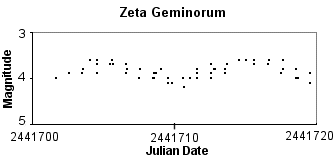 |
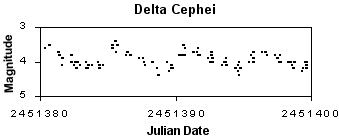 |
| The top image is a light curve of Zeta Gem displaying the symmetric characteristic of its light curve. The bottom image shows the distinctive "fin-like" shape of the Delta Cep light curve. |
Our sparkling star, Zeta Gem, is classified as a Delta Cephei type variable despite a rather blatant deviation from its prototype star. Delta Cep stars display a distinctive "fin-like" shape, characterized by a steep rise to maximum, a brief pause while at its brightest, and then a gradual decline to minimum. Zeta Gem, however, has a rather symmetric light curve, with the declining and rising phases each taking half of the 10.15-day cycle. In some instances, there also seems to be a "hump" on the ascending branch of Zeta Gem. Regardless of this disparity, Zeta Gem has a period of 10.15 days, a .6 change in magnitude and a period-luminosiy relation that classifies it among the Delta Cephei type pulsating variable stars.
Cepheids and the Third Dimension
Classical Cepheids, including Zeta Gem, are some of the most important astronomical objects in the sky. They extend our understanding of the universe and are essential in determining extragalactic distance scales.
Cosmology and Distance Measurements
How old is the universe? How fast is it expanding? Will it one day start to contract? These are fundamental cosmological questions that have long awaited satisfactory answers. The fate of the universe is closely linked with the future behaviour/evolution of its expansion rate. If the expansion slows down sufficiently then the Universe may one day start to recontract. Observations currently suggest that it is more likely that the Universe will continue to expand forever (ESO/ESA, p.3).
The expansion makes all galaxies recede from a given observer (i.e. Earth) and the farther away they are, the faster they recede. The expression known as Hubble's law (formulated by Edwin Hubble in 1929) describes the relation between the distance of a given object and its recession velocity. Hubble's law is:
v = H0 · D
It states that the galaxies in our Universe are flying away from each other with a velocity, v, proportional to the distance, D, between them. H0 is a fundamental property of the Universe - the Hubble constant - important in many cosmological questions and is a measure of how fast the Universe is expanding today. The age of the Universe, t, can be approximated by the inverse (or reciprocal) of the Hubble constant H0:
t = 1/H0
The value of H0 has enormous significance for estimates of the age of our Universe. But how do we measure it? To determine H0, we 'simply' need to measure both the recession velocity, v, and the distance, D, for an object, usually a galaxy, or, even better, for many galaxies and find the average measurement.
The recession velocity is relatively easy to determine because we can measure the so-called redshift of the light from a galaxy. Redshift is the name used to describe the displacement of spectral lines in the radiation received from a source due to its motion away from the observer. The spectral lines are shifted toward the red end of the electromagnetic spectrum and so the term redshift is used (blueshifted light is displaced toward the blue end of the spectrum and reflects motion approaching the observer). Galaxies with a high redshift have high recession velocities.
Cepheids as Distance Estimators — the Period-Luminosity Relation
Measuring the distance to an astronomical object is much more difficult and is one of the greatest challenges facing astronomers. Over the years a number of different distance estimators have been found, one of these is the class of variables to which Zeta Gem belongs, the Cepheid variables.
 |
| Henrietta S. Leavitt |
Henrietta Swan Leavitt, working with Cepheids, revolutionized the understanding of relative brightness and variability of stars. Out of 20,000 pulsating variable stars catalogued by astronomers today, Miss Leavitt (1868-1921), discovered more than 10% of these while working for Edward Charles Pickering at Harvard University. Her tedious task was to compare two photographs of the same field of stars taken at different times, and detect any star that varied in brightness. Eventually she discovered 2400 classical Cepheids, most of them located in the Small Magellanic Cloud (SMC), with periods between 1 and 50 days. Leavitt took advantage of this opportunity to investigate the nature of the classical Cepheids in the SMC. Noticing that the more luminous Cepheids had longer periods, she plotted the apparent magnitudes of these stars against their pulsation periods. The resulting graph, shown in Fig. 3 demonstrates that the apparent magnitudes of classical Cepheids are closely correlated with their periods. But what about the intrinsic luminosities? Do some of these stars appear brighter just because they are closer to us, or are they really intrinsically brighter stars? The small variations in distance to the individual Cepheid variable stars in the Cloud is negligible compared with the much larger distance to the SMC, so the distances to these cepheids is assumed to be the same. Since they are the same distance away, then the differences in apparent brightness among these stars must be due to differences in their intrinsic brightnesses (or luminosities). Thus a relation between intrinsic luminosity (absolute magnitude) and the period of a cepheid star could now be determined. The wonderful potential of this period-luminosity relation, is that now, when observing the period of any Cepheid star, one can deduce its intrinsic brightness or luminosity.
Astronomers were excited at the prospect of determining the absolute magnitude of a distant Cepheid simply by timing its pulsation, because knowing both a star's apparent and absolute magnitudes allows the distance of the star to be easily determined by way of the distance modulus [ m - M = 5log10(d) - 5 where m is the apparent magnitude, M is the absolute magnitude and d is the distance ] . The only stumbling block was the calibration of Leavitt's relation. An independently determined distance to a single Cepheid had to be obtained to measure its absolute magnitude and luminosity. Once this difficult chore was accomplished, the resulting period-luminosity relationship could be used to measure the distance to any Cepheid. This relation for Cepheid variables has been revised many times since Henrietta Leavitt's first measurements. Today the best estimate of the relation is:
where M is the absolute magnitude of the star and P is the period measured in days. (ESA/ESO, p. 8).
Thus Classical Cepheids provide astronomy with its third dimension and supply the foundation for the measurement of extragalactic distances. Because Cepheids are supergiant stars (luminosity class Ib), about fifty times the Sun's size and thousands of times more luminous, they can be seen over intergalactic distances. They serve as "standard candles," beacons scattered throughout the night sky that serve as mileposts for astronomical surveys of the universe.
Zeta Gem Settles the Score
 |
| An aerial view of the Palomar Testbed Interferometer, funded by NASA to demonstrate technology for ground-based interferometry. Light collected by three small telescopes in the three small buildings is directed through pipes to the central beam combining building. The separation among the three telescopes is 110 meters. |
In a recent landmark observation, the period-luminosity relationship was improved by a factor of three due to direct observations of our Cepheid variable star of the month, Zeta Gem. Earlier astronomers inferred the size of the oscillations indirectly, through the well-known phenomenon of the Doppler shift. Seeing the size change directly, however, has been a daunting challenge in precision astronomy. Given Zeta Geminorum's diameter as seen from Earth, observing it grow and shrink would be the equivalent to spotting a basketball on the moon. To accomplish this feat, a five-person research team from the California Institute of Technology in Pasadena used two telescopes linked into a 110-meter-wide interferometer, the Palomar Testbed Interferometer (PTI) in California. The PTI has as much angular resolving power as a telescope with a mirror larger than a football field. By December 1999 graduate student Ben Lane of the research team already had clear evidence of the star's growth and shrinking, and by the Spring of 2000 he had the most accurate estimate ever of the angular size of the oscillations. Then, by dividing the angular size of the oscillations into their absolute size (as inferred from redshift measurements), Lane calculated the distance of Zeta Geminorum as 1100 light-years from Earth (Lane, 2000).
Researchers using the Infrared and Optical Telescope Array (IOTA) located on top of Mt. Hopkins, Arizona, have recently made independent observations of Zeta Gem, that are very close to the measurements obtained by the Lane research team (Kervella, P. et. al., 2001).
The significance of these observation is great and it holds exciting possibilities for our understanding of the universe. Jeremy Mould, an astronomer at the Australian National University in Canberra says, "In time, measurements like these will simplify and therefore strengthen astronomers' measurements of the distances of galaxies, and thus the size and age of the universe" (Daily InScight, 2000).
Observing Zeta Gem
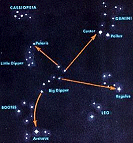 |
 |
| Click images to enlarge. Can you find Zeta Gem in the night sky? |
Can you see the pulsations of Zeta Gem? Well.... you probably won't be able to measure the star's physical changes as precisely as the research teams using large interferometers, however, Zeta is a bright variable high in the sky right now and you should be able to detect changes in its brightness. The observing activity in the AAVSO educational project, Hands-On Astrophysics will help you locate and observe Zeta Gem if you are new to variable star observing. First find Orion the Hunter, then look above and to the left of Orion to locate Gemini. Castor and Pollux are the most conspicuous stars in the constellation. Gemini will appear about the same size as your hand held at arm's length. The chart at the left shows the location of Zeta Gem (circled) and some of the bright stars in Gemini. The magnitudes are given for several non-variable stars. These stars are the comparison stars that you will use to estimate the magnitude of Zeta Gem. The most convenient stars to use as comparison stars are Lambda Gem (below and to the left of Zeta) at visual magnitude 3.6, and Nu (to the right of Zeta) at magnitude 4.2 (both are underlined). Zeta Gem varies approximately between these two magnitudes. For example, if the brightness of Zeta appeared to be halfway between the brightness of Lambda and Nu, you would estimate its magnitude as 3.9. If Zeta appears only slightly fainter than Lambda, you would estimate the magnitude as 3.7.
If you are new to estimating the brightness of variable stars, try our powerpoint presentation on the website called the Variable Star Telescope Simulator. Also, the Hands-On Astrohpysics website, manual, and video contain valuable resources to the new observer on how to make estimates of a variable star. Finally, the Manual for Visual Observing of Variable Stars is a comprehensive guide to variable star observing and is also available on our website.
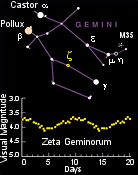 |
| Finder chart and light curve for Zeta Gem. Sky and Telescope illustration. |
Once you have located Gemini, Zeta Gem, and the comparison stars Lambda and Nu in the night sky, you are ready to start observing the variation in brightness of Zeta Gem and recording your observations. Follow the instructions in the Zeta Gem activity for more information on recording your observations, and visit our Contributing Data section of the website to learn how to submit your observations to be included in the AAVSO International Database.
Happy Observing!!
Gemini (the Twins)From the HOA Manual and Star Lore of All Ages:
Castor and Pollux accompanied Jason and the Argonauts in their search for the Golden Fleece, and had many great adventures. Afterwards, Castor was killed during a cattle raid. Pollux, who was immortal, mourned for his brother and wanted to follow him into Hades (the underworld). Zeus took pity on his son Pollux and allowed him and his brother to visit on alternate days Hades and Mount Olympus (where the gods lived). Among the ancients, and particularly among the Romans, there prevailed a superstition that Castor and Pollux often appeared at the head of their armies, and led on their troops to battle and victory.
Castor and Pollux were a common object of adjuration among the Romans, and the slang of the present day, "By Jiminy," is a survival of the old Roman oath. |
For More Information
- Ashbrook, J.; "Astronomical Scrapbook: Julius Schmidt and His Book About Lunar Eclipses", Sky and Telescope, March, 1977, p. 173.
- Cambell, Leon and Jacchia, Luigi. The Story of Variable Stars, Harvard Books on Astronomy, 1941.
- Mackenzie, Dana "Measuring a Giant's Sighs", Science Magazine, 27 September, 2000.
- The ESA/ESO Astronomy Exercises Series, "The Distance to M100 as Determined By Cepheid Variable Stars", Based on observations with the NASA/ESA Hubble Space Telescope.
- Goldberg, L. and Aller, L.H.; Atoms, Stars, and Nebulae, Harvard Books on Astronomy, 1943.
- Hands-On Astrophysics, "Winter Variable Star Observing Activity in the Constellation Gemini".
- Kervella, P. et. al., "The Angular diameter and distance of the Cepheid z Geminorum", Astronomy and Astrophysics, 367, 876-883, 2001.
- Lane, B.F., Kuchner, M.J., Boden, A.F., Creech-Eakman, M., and Kulkarni, S.R., "Direct detection of pulsations of the Cepheid star z Gem and an independent calibration of the period-luminosity relation", Nature, 407, 485-487, 2000.
- Olcott, William Tyler; Star Lore of All Ages, New York, 1911.
- Ostlie, Dale A. and Carroll, Bradley W.; An Introduction to Modern Stellar Astrophysics, Weber State University, 1996.
- Turner, David G.; "Monitoring The Evolution of Cepheid Variables", The Journal of the American Association of Variable Star Observers, 26, 101-111, 1998.
This month's Variable Star of the Month was prepared by Kate Davis, AAVSO Technical Assistant, Web.





